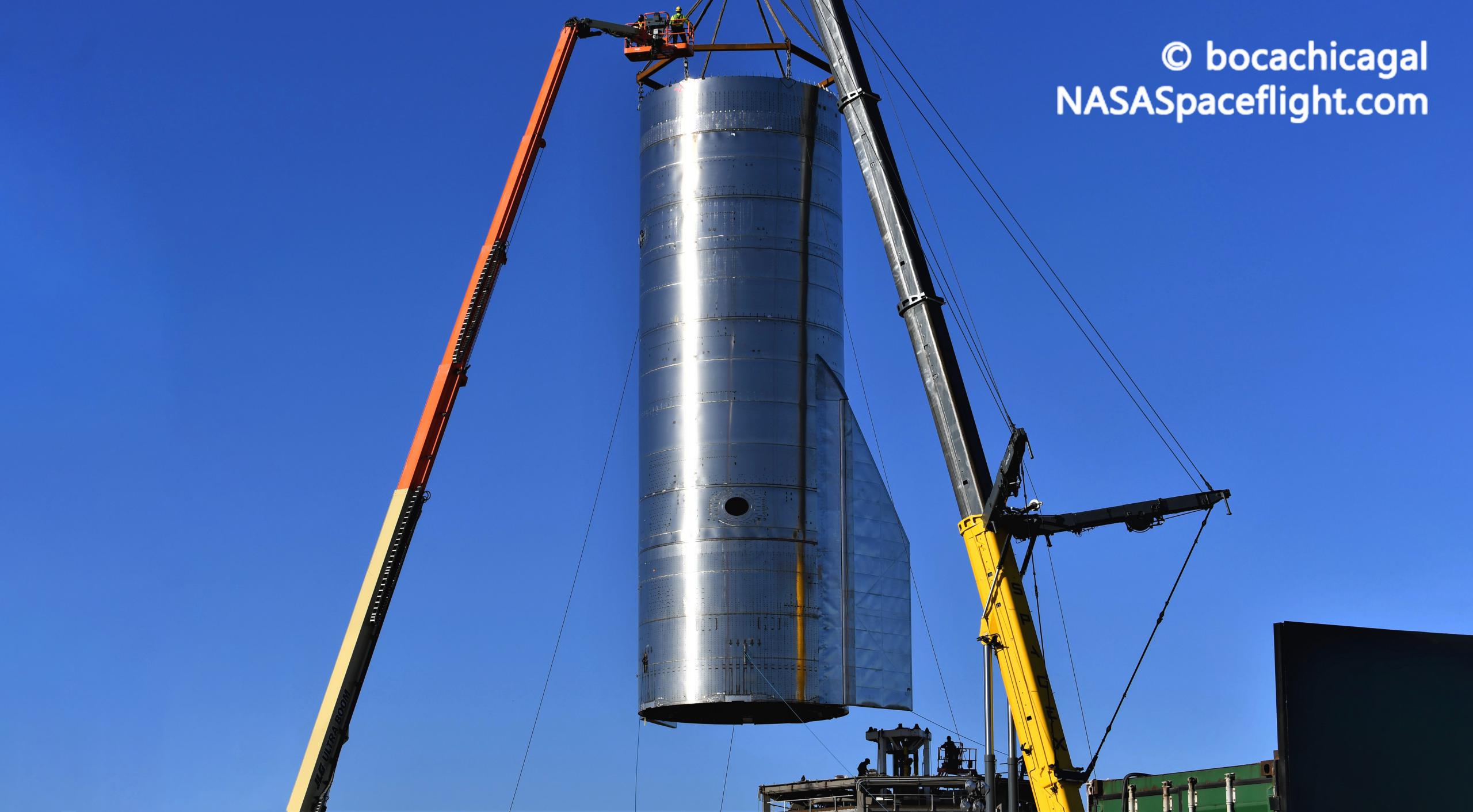
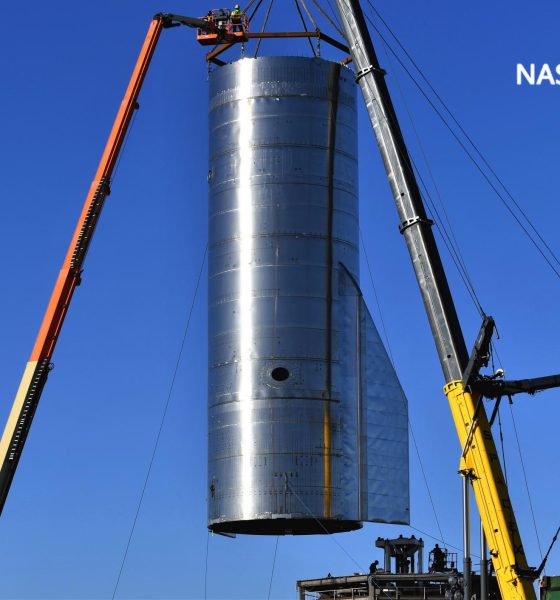
News
SpaceX’s first high-altitude Starship fitted with flaps and rolled to the launch pad
After a four-day delay, SpaceX has successfully installed the first high-altitude Starship at its Boca Chica launch pad not long after the rocket was outfitted with large flaps.
Technically the second time a Starship was outfitted with flaps, Starship serial number 8 had the bottom half of its aerodynamic control surfaces installed on September 23rd – exactly one year after Starship Mk1’s flaps were first installed. Starship Mk1’s flaps were likely meant to be functional but SpaceX never appeared to activate them and Mk1’s main body (tank section) was destroyed during a November 2019 pressure test, failing far before the necessary pressures for flight tests. As such, barring a surprise or two, Starship SN8 will very likely become the first flightworthy prototype to have functional flaps installed.
That remains to be seen, though, and will be put to the test over the next few weeks. If all goes according to plan, the ship could become the first to attempt a high-altitude, 15 km (9.3 mile) launch and landing testing, likely also becoming the first Starship to break the sound barrier.
Starship SN8’s first steps toward testing began on September 26th when SpaceX loaded the rocket onto a self-propelled mobile transporter (SPMT) and rolled it to the company’s dedicated Boca Chica launch and test facilities. Shortly after arrival, a crane and load spreader was attached to the rocket to lift it onto one of the pad’s test stands (Stand A). That lift never came and the crane eventually detached and retracted, kicking off what would become an unusual four-day delay.
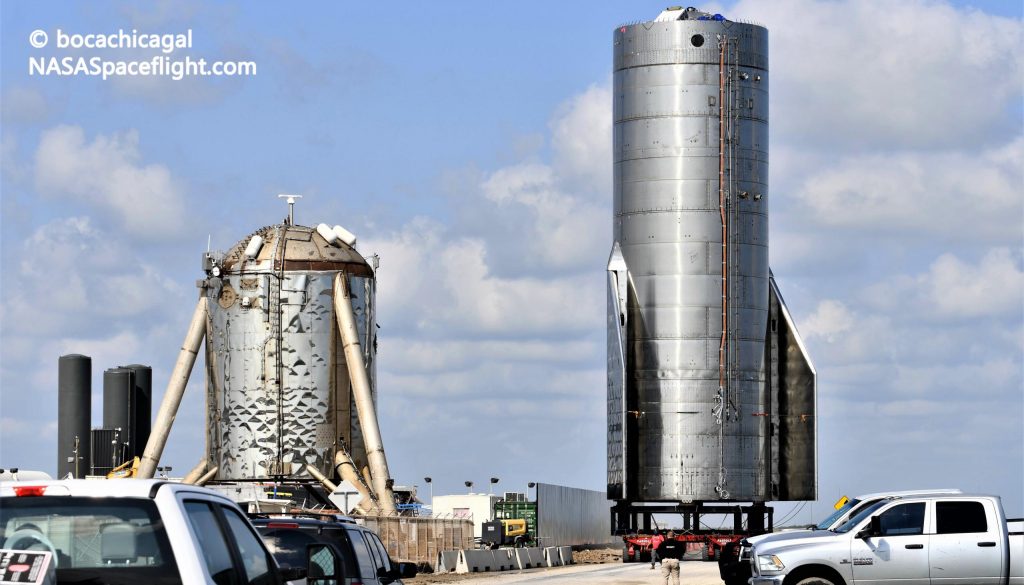
It’s believed that the relatively high winds on the Boca Chica coast were to blame, creating conditions that were too hazardous to risk the precise, hands-on work required to lift and manipulate a ~70 metric ton (~150,000 lb) rocket. While undeniably heavy, an empty Starship’s huge surface area effectively turns it into a giant sail, catching and amplifying wind gusts. Attaching a Starship to a launch mount’s hold-down clamps likely demands millimeter precision, making installation and high winds obviously incompatible (or at least inadvisable).
Finally, around midnight on September 30th, winds died down in Boca Chica and SpaceX fired up a waiting crane and lifted Starship SN8 onto the launch mount. Soon after, technicians began the process of installing the mount’s temporary hydraulic ram – used to mechanically simulate engine thrust – to the rocket’s ‘thrust puck’.
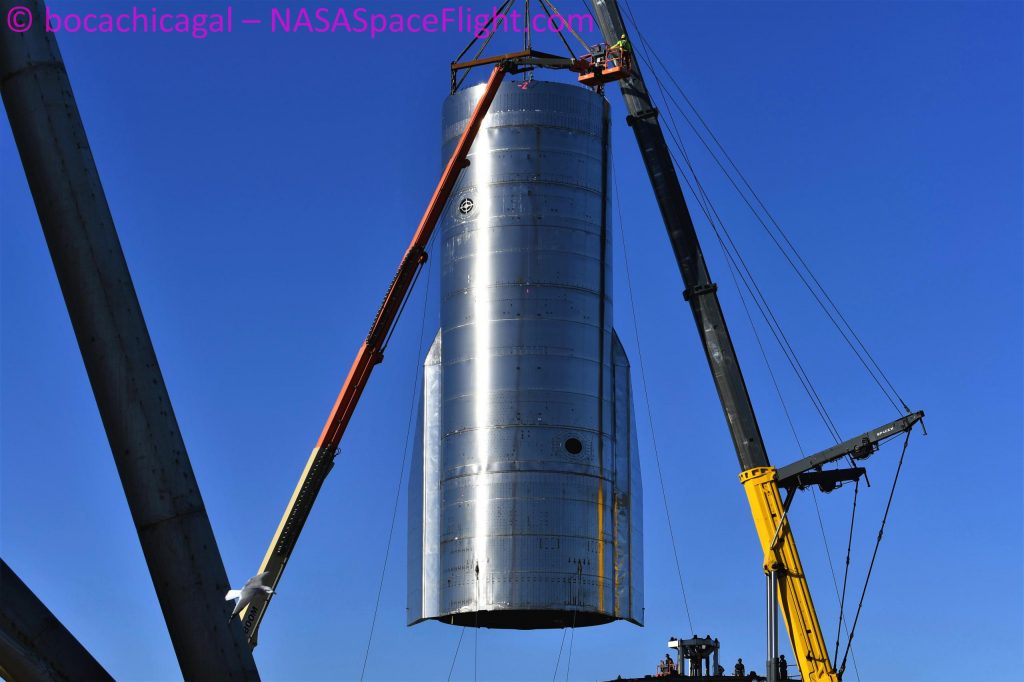
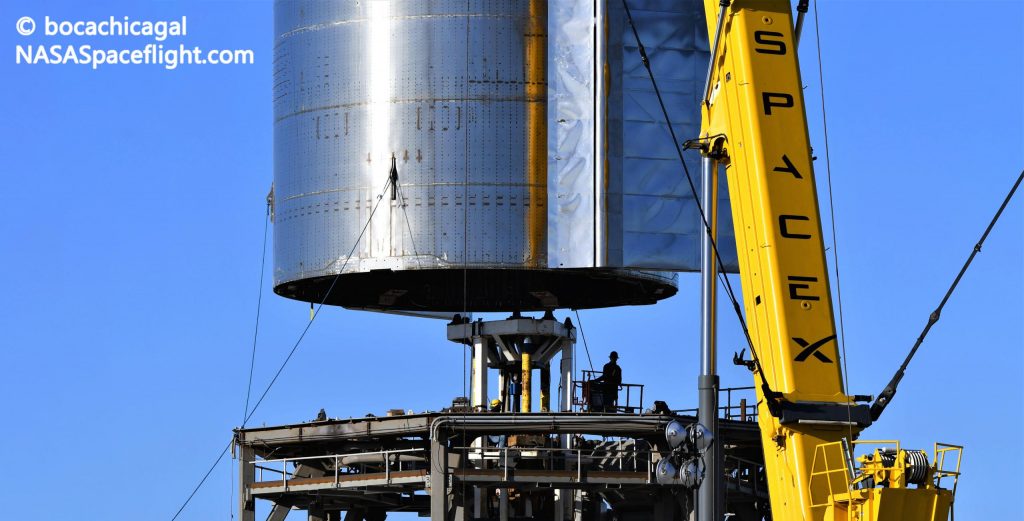
Like every Starship prototype since Mk1, Starship SN8’s first major challenge will involve passing an acceptance test known as a “cryogenic proof.” After being pressurized with ambient-temperature nitrogen gas to check for leaks, SN8 will be fully filled with liquid nitrogen while the hydraulic ram subjects its thrust puck and engine section to stresses similar to the thrust of three Raptor engines. Together, three Raptors are capable of producing more than 600 metric tons (1.3 million lbf) of thrust. For reference, four Raptors would effectively match the thrust of an entire Falcon 9 booster with all nine Merlin 1Ds at full throttle.
If SN8 reaches the necessary pressure and survives the stress of its cryo proof(s), it will likely become the first Starship to attempt a triple-Raptor static fire – a first for the engine, too. Starship SN8’s first cryo proof attempt is scheduled no earlier than 9pm-6am CDT (UTC-5) on Sunday, October 4th with backup windows on the 5th and 6th. The first static fire attempt – possibly beginning with one Raptor or jumping straight to three – could happen several days after a successful cryo proof.
According to Elon Musk, SpaceX will static fire SN8 twice before attempting its 15 km (~50,000 ft) launch debut. More likely than not, SpaceX will attempt a triple-engine static fire with the Starship as-is, install SN8’s nosecone and forward flaps, and attempt a second static fire while only drawing propellant from tbe rocket’s smaller header tanks (one of which is located in the tip of its nose). Only time (or Elon tweets) will tell.

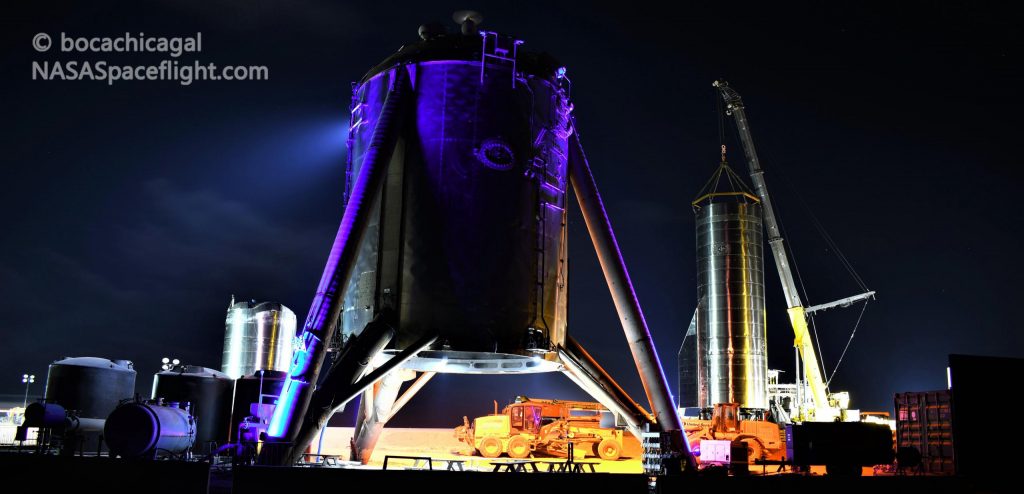
Check out Teslarati’s Marketplace! We offer Tesla accessories, including for the Tesla Cybertruck and Tesla Model 3.

News
Waymo scrutinized after self-driving taxis cause traffic jams during SF blackout
It’s not farfetched to speculate that it would have been a doomsday scenario for Tesla had FSD behaved this way.

A power outage across San Francisco over the weekend forced numerous Waymo self-driving taxis to stop at darkened intersections and cause traffic blockages in multiple locations across the city. The disruption left riders stranded, frustrated drivers blocked, and city officials stepping in as the Alphabet-owned company temporarily suspended service amid the widespread gridlock.
Needless to say, it would likely have been a doomsday scenario for Tesla had FSD behaved in a similar way, especially if fleets of its robotaxis blocked traffic for numerous drivers.
Power outage halts Waymo fleet
The outage knocked out electricity for tens of thousands of customers, leaving traffic signals dark across large parts of the city, as noted in a report from the New York Times. Waymo vehicles began stopping at intersections and remained stationary for extended periods, seemingly unable to operate. Tow truck operators worked through the night removing immobilized vehicles, while videos circulated online showing Waymos with hazard lights flashing as traffic backed up around them.
Waymo later confirmed that it had paused its Bay Area ride-hailing service after the San Francisco mayor’s office contacted the company about the congestion its vehicles were contributing to. Service began coming back online shortly after 3:30 p.m. local time, though some users still reported being unable to request rides. Waymo maintained that no injuries or accidents were reported during the outage.
Autonomous cars during emergencies
The incident surprised industry observers since autonomous vehicles are designed to function during signal outages and temporary connectivity losses. Waymo stated that its vehicles treat nonfunctional signals as four-way stops, but “the sheer scale of the outage led to instances where vehicles remained stationary longer than usual to confirm the state of the affected intersections. This contributed to traffic friction during the height of the congestion.” Experts suggested the problem may have been linked to the vehicles’ reliance on remote assistance teams, which help resolve complex situations the cars cannot handle independently.
“Yesterday’s power outage was a widespread event that caused gridlock across San Francisco, with non-functioning traffic signals and transit disruptions. While the failure of the utility infrastructure was significant, we are committed to ensuring our technology adjusts to traffic flow during such events,” the Waymo spokesperson stated, adding that it is “focused on rapidly integrating the lessons learned from this event, and are committed to earning and maintaining the trust of the communities we serve every day.”
News
Tesla aims to combat common Full Self-Driving problem with new patent
Tesla writes in the patent that its autonomous and semi-autonomous vehicles are heavily reliant on camera systems to navigate and interact with their environment.

Tesla is aiming to combat a common Full Self-Driving problem with a new patent.
One issue with Tesla’s vision-based approach is that sunlight glare can become a troublesome element of everyday travel. Full Self-Driving is certainly an amazing technology, but there are still things Tesla is aiming to figure out with its development.
Unfortunately, it is extremely difficult to get around this issue, and even humans need ways to combat it when they’re driving, as we commonly use sunglasses or sun visors to give us better visibility.
Cameras obviously do not have these ways to fight sunglare, but a new patent Tesla recently had published aims to fight this through a “glare shield.”
Tesla writes in the patent that its autonomous and semi-autonomous vehicles are heavily reliant on camera systems to navigate and interact with their environment.

The ability to see surroundings is crucial for accurate performance, and glare is one element of interference that has yet to be confronted.
Tesla described the patent, which will utilize “a textured surface composed of an array of micro-cones, or cone-shaped formations, which serve to scatter incident light in various directions, thereby reducing glare and improving camera vision.”

The patent was first spotted by Not a Tesla App.
The design of the micro-cones is the first element of the puzzle to fight the excess glare. The patent says they are “optimized in size, angle, and orientation to minimize Total Hemispherical Reflectance (THR) and reflection penalty, enhancing the camera’s ability to accurately interpret visual data.”
Additionally, there is an electromechanical system for dynamic orientation adjustment, which will allow the micro-cones to move based on the angle of external light sources.
This is not the only thing Tesla is mulling to resolve issues with sunlight glare, as it has also worked on two other ways to combat the problem. One thing the company has discussed is a direct photon count.
CEO Elon Musk said during the Q2 Earnings Call:
“We use an approach which is direct photon count. When you see a processed image, so the image that goes from the sort of photon counter — the silicon photon counter — that then goes through a digital signal processor or image signal processor, that’s normally what happens. And then the image that you see looks all washed out, because if you point the camera at the sun, the post-processing of the photon counting washes things out.”
Future Hardware iterations, like Hardware 5 and Hardware 6, could also integrate better solutions for the sunglare issue, such as neutral density filters or heated lenses, aiming to solve glare more effectively.
Elon Musk
Delaware Supreme Court reinstates Elon Musk’s 2018 Tesla CEO pay package
The unanimous decision criticized the prior total rescission as “improper and inequitable,” arguing that it left Musk uncompensated for six years of transformative leadership at Tesla.

The Delaware Supreme Court has overturned a lower court ruling, reinstating Elon Musk’s 2018 compensation package originally valued at $56 billion but now worth approximately $139 billion due to Tesla’s soaring stock price.
The unanimous decision criticized the prior total rescission as “improper and inequitable,” arguing that it left Musk uncompensated for six years of transformative leadership at Tesla. Musk quickly celebrated the outcome on X, stating that he felt “vindicated.” He also shared his gratitude to TSLA shareholders.
Delaware Supreme Court makes a decision
In a 49-page ruling Friday, the Delaware Supreme Court reversed Chancellor Kathaleen McCormick’s 2024 decision that voided the 2018 package over alleged board conflicts and inadequate shareholder disclosures. The high court acknowledged varying views on liability but agreed rescission was excessive, stating it “leaves Musk uncompensated for his time and efforts over a period of six years.”
The 2018 plan granted Musk options on about 304 million shares upon hitting aggressive milestones, all of which were achieved ahead of time. Shareholders overwhelmingly approved it initially in 2018 and ratified it once again in 2024 after the Delaware lower court struck it down. The case against Musk’s 2018 pay package was filed by plaintiff Richard Tornetta, who held just nine shares when the compensation plan was approved.
A hard-fought victory
As noted in a Reuters report, Tesla’s win avoids a potential $26 billion earnings hit from replacing the award at current prices. Tesla, now Texas-incorporated, had hedged with interim plans, including a November 2025 shareholder-approved package potentially worth $878 billion tied to Robotaxi and Optimus goals and other extremely aggressive operational milestones.
The saga surrounding Elon Musk’s 2018 pay package ultimately damaged Delaware’s corporate appeal, prompting a number of high-profile firms, such as Dropbox, Roblox, Trade Desk, and Coinbase, to follow Tesla’s exodus out of the state. What added more fuel to the issue was the fact that Tornetta’s legal team, following the lower court’s 2024 decision, demanded a fee request of more than $5.1 billion worth of TSLA stock, which was equal to an hourly rate of over $200,000.
Delaware Supreme Court Elon Musk 2018 Pay Package by Simon Alvarez








